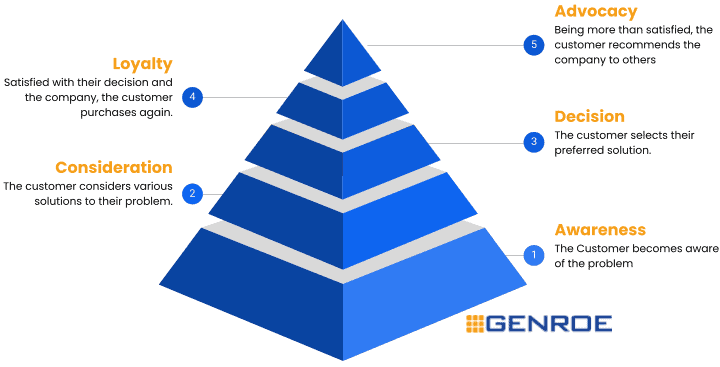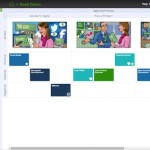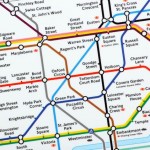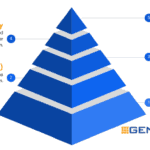In many ways the retail customer journey is no different to the customer journeys for other industries: it seeks to identify the steps retailer’s customers make through the course of their interaction with a company.
It is true though that in the last 20 years it has become much more complex because of the impact of the internet on the way customers move along the journey and the introduction of on-line and mixed steps.
The journey has never been strictly linear, as the diagram might indicate, customers move back and forth along the journey based on their individual circumstance.
There is also no single, agreed, retail customer journey. Some versions end at the purchase, others rename, combine or separate elements, but all include the ideas outlined in this post.


Stage 1: Awareness
In this first stage of the customer journey, the customer becomes aware of their “problem”.
I’ve put the problem in inverted commas because the problem might be a desire or want for a product or service. In this case “problem” is used in a very general sense.
Customers may become aware of their problem in various ways including:
- Awakening a desire through seeing your product or service on social media.
- Walking past a display in a store
- Seeing an advertisement online or in mass media.
As you can see, while this is a retail journey, it doesn’t centre only in-store. Customers can take steps on the journey in settings other than bricks and mortar.
While the methods of generating retail customer awareness are well known, it’s difficult to measure their effectiveness.
Stage 2: Consideration
Here the customer considers various ways to solve their problem. They may look at competing retailers or manufacturers of the same product or service.
However, they may also consider alternate ways to solve the problem, in which case the consideration set may include non-competing retailers and brands.
They will undertake this consideration process in a variety of ways
- Comparing merchandise in the same physical or on-line store
- Asking friends for suggestions
- Reviewing social media
- etc
Again, it’s clear that the retail customer journey is not limited to either on-line or bricks and mortar sites.
Measurement of the Consideration stage is typically done via some type of brand awareness approach. While this doesn’t fully capture the Consideration stage it certainly helps.
Stage 3: Decision
Having examined at the various options, customers then move to make a decision that solves their “problem”.
Typically they will consider a range of objective elements such as:
- Price
- Availability: in-stock, on back order, not available
- Preferred colour, size, etc
But they will also consider a range of subjective elements such as:
- Brand persona
- Peer group norms
- Influencer recommendations
- Self-image
- etc
We see again that the retail customer journey is impacted far beyond the in-store experience.
Of course, the ultimate metric of the Decision stage is sales.
Stage 4: Loyalty
Where the customer is at least satisfied with their purchase, and where the “problem” is a recurring one, they enter the loyalty phase of the retail customer journey.
In the Loyalty phase the customer re-purchases the product or service into the future. Achieving good customer loyalty is one of the keys to delivering long term business growth and retaining a customer is generally accepted to be easier than gaining a new one.
There are many ways to improve customer loyalty including:
- The use of Loyalty cards and programs.
- Delivering products and services that are better than your competitors. Here “better” may be subjective or objective.
In terms of identifying when your products and service are better than your competitors, the Net Promoter Score (NPS) metric has been shown to be an effective predictor of retail customer loyalty.
Stage 5: Advocacy
The final stage of the customer journey is Advocacy. Not only is the customer loyal, they also advocate on behalf of the company: they effectively become an unpaid sales person for the retailer.
Advocacy can in itself be a powerful driver of company growth especially when combined with on-line and social media tools.
Sharing positive reviews of the company to friends and family is known to drive additional sales.
Again NPS is a common way to measure retail customer advocacy.










